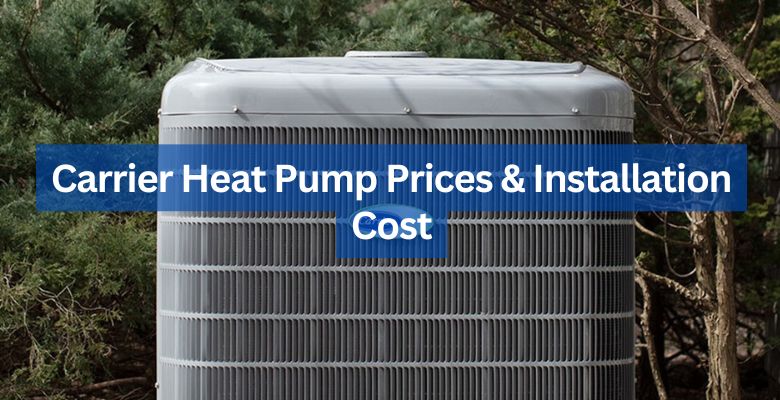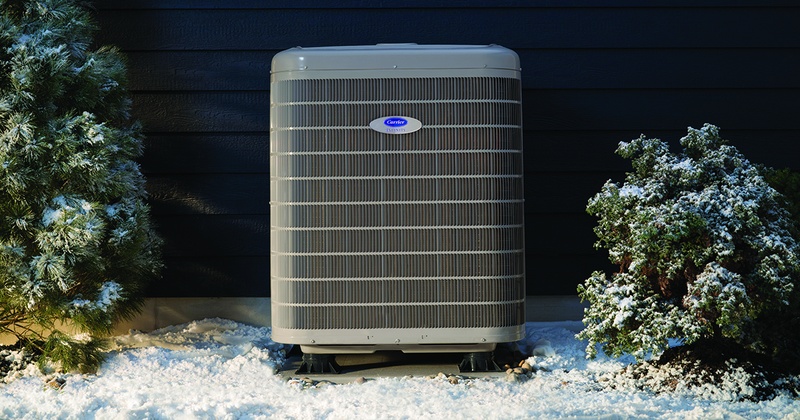
Carrier heat pumps may be considered as a reliable, energy-efficient, and well-known brand when it comes to home heating and cooling solutions in the United States. This summary shows the average costs of 2.5-ton, 3-ton, 4-ton and 5-ton Carrier units including equipment and installation. The real costs may differ depending on efficiency ratings, labor charges and climate needs of the area. A brief overview of rough prices is given below:
| Tonnage | Approx. Unit Price | Approx. Total Installed Cost |
|---|---|---|
| 2.5 Ton | $3,500 – $5,500 | $6,000 – $9,000 |
| 3 Ton | $3,800 – $6,200 | $6,500 – $10,000 |
| 4 Ton | $4,500 – $7,500 | $7,500 – $11,000 |
| 5 Ton | $5,000 – $8,500 | $8,500 – $12,000 |
How Much Does a 2.5 Ton Carrier Heat Pump Typically Cost?

A 2.5-ton Carrier heat pump is usually appropriate in small to medium-sized houses, that is, houses of about 1,500 to 1,800 square feet with moderate insulation and normal ceiling heights. This is a capacity that can effectively manage the normal heating and cooling loads without straining the system as long as the layout of the home and the climate needs are in line with the output of the unit.
A lot of homeowners like the combination of initial price and energy efficiency. A 2.5-ton Carrier heat pump can cost anywhere between 3,500 and 5,500 dollars on the equipment and 6,000 to 9,000 dollars installed. These numbers may vary depending on such factors as local labor costs, ductwork quality and efficiency improvements.
How Much Does a 3 Ton Carrier Heat Pump Typically Cost?

The 3-ton Carrier heat pump is widely used in homes that are more on the 2,000 square feet or in homes that are a little older and might have some air leakage or weaker insulation. The additional capacity assists in ensuring that the indoor temperatures remain constant despite the changes in the outdoor temperatures.
The unit itself can cost between $3,800 and $6,200 depending on the efficiency rating and special features (such as variable-speed compressors) and the total installation can usually cost between $6,500 and $10,000. Open floor plan homes or homes with partial second stories usually benefit with the smoother and stronger airflow that a 3-ton system offers.
How Much Does a 4 Ton Carrier Heat Pump Typically Cost?

A 4-ton Carrier heat pump is more suitable to bigger houses and houses with more than one room or more than one floor. This capacity is able to cover homes that are more than 2,000 square feet especially when the ceilings are above the average or when there are numerous people who produce heat inside the house.
Unit cost alone is usually between 4,500 and 7,500 dollars. Installed, it costs approximately $7,500 – $11,000, which is the additional labor, materials and potential modifications to the existing ductwork that a larger system may necessitate. Although the initial investment of this larger system is more, it is capable of providing more consistent temperature control and better humidity control in large living spaces.
How Much Does a 5 Ton Carrier Heat Pump Typically Cost?
A 5-ton Carrier heat pump is meant to be installed in large homes, usually 2,500 square feet or larger, or in homes in areas with large temperature variations. The increased capacity guarantees that the occupants will be comfortable in the hottest summers or the coldest winters and there will be less need to provide supplementary heating or cooling.
The prices of units only range between 5000 and 8500 dollars, but a full professional installation can cost between 8500 and 12000 dollars. A 5-ton system has greater initial expenses, but it may be a stable option in case of large or unusual floor plans that require a powerful heating and cooling capacity.
Why Do Carrier Heat Pump Prices Vary by Tonnage?
Carrier heat pump models are categorized based on tonnage, which is associated with the cooling and heating capacity of the system. HVAC tonnage is a unit of measurement that represents the amount of heat that the unit can remove (or add) in a given period of time.
Bigger houses normally have bigger units to keep the house cool inside.
Don’t Overpay for HVAC Services – Call 888-894-0154 Now to Compare Local Quotes!
Heating and Cooling Load Requirement
It is important to properly size the load of a home. A 2.5-ton Carrier heat pump may be adequate in smaller homes with less square footage and moderate climate, whereas a 5-ton system is aimed at larger homes or homes in areas with extreme temperatures.
Poor sizing may lead to short cycling, energy wastage, and increased long-term operating costs.
Variation in Cost of Components
Tonnage growth is accompanied by the growth in size and complexity of such important components as compressor and fan motors.
The coils made of copper or aluminum should be able to process more refrigerant. Such variations lead to increased costs of manufacturing that are passed on to the ultimate price of purchase.
Market Supply and Demand
The medium-sized capacities (3-ton and 4-ton units) are more demanded in most regions since they suit the requirements of average-sized houses.
There are some cases when popular tonnages are competitively priced because of the economies of scale. On the other hand, rare sizes can have higher or more fluctuating costs because of smaller production and availability.
What Factors Affect the Total Installation Cost?
Although the difference in cost can be attributed to the unit capacity, there are a number of other factors that determine the total cost of an installation of a Carrier heat pump.
- Geographic Location
The cost of installation in big cities may be more due to high labor and permit charges. In the meantime, rural homeowners can be charged more on transportation expenses in case an HVAC company has to travel long distances.
- Efficiency Ratings (SEER and HSPF)
Carrier heat pumps are available in various levels of efficiency, which are usually marked by their SEER (Seasonal Energy Efficiency Ratio) and HSPF (Heating Seasonal Performance Factor) ratings.
The high-efficiency systems are able to cut down the monthly utility bills, but the advanced technology is associated with a high initial cost. In the long run though, the energy savings may cover the premium you pay.
- Ductwork and Indoor Air Handler
A Carrier heat pump normally is used with an indoor air handler or furnace (in a dual-fuel system). When the current air handler is old or incompatible, it should be replaced to work at its best.
The condition of ductwork is also important: old or leaky ducts might require sealing or replacement to avoid energy losses and guarantee the correct airflow, which increases labor and material expenses.
- Refrigerant Lines and Accessories
Older systems can be equipped with old refrigerants which are not permitted in the present environmental laws. In that case, the installer will have to replace or modify refrigerant lines, increase their capacity, or change them to new standards of refrigerants.
Other accessories, like high-tech thermostats, zoning systems, or entire-house air cleaners, may also increase the total price.
- Difficulty of Installation
When structural work is needed on the home, electrical work, or more concrete pads to place outdoor units on, labor is more.
In the same way, when the heat pump is replacing an older system that was located in an inaccessible location, the technician might require additional time and special tools to finish the work
How Does Efficiency Influence Carrier Heat Pump Pricing?
Energy efficiency is also a major selling point to homeowners especially those who want to cut down their monthly utility bills.
Don’t Overpay for HVAC Services – Call 888-894-0154 Now to Compare Local Quotes!
The product lines offered by Carrier are standard-efficiency, mid-efficiency and high-efficiency units which have varying technologies.
High-Efficiency Models
Infinity series of Carrier usually has variable-speed compressors, improved refrigerant controls, and improved heat exchangers.
Such units usually boast of increased SEER and HSPF values. Even though these models are expensive, they provide reduced operational costs in the long term.
They are also available with possible state or federal rebates depending on the current energy-saving programs.
Mid-Efficiency to Standard Models
In Performance series and Comfort series, emphasis is on providing sufficient efficiency, dependable performance and easier operation at a lower initial cost.
The models tend to be single-stage or two-stage compressor, with fewer high-end parts, and slightly lower SEER/HSPF ratings.
Possible Return on Investment
Homeowners usually consider the payback period when considering Carrier heat pump prices.
A high-efficiency model may be worth it when electricity rates are high in the area, when the homeowner intends to remain in the house a long time, or when local utility rebates make the initial cost much lower.
Which Features Increase the Cost of a Carrier Heat Pump?
In addition to capacity and efficiency, Carrier has a number of features that may affect the price:
- Variable-Speed Compressors: Offer accurate temperature and improved humidity control. This aspect normally increases the cost of a unit and the complexity of installation.
- Smart Thermostats: Carrier smart thermostats are able to optimize energy consumption, provide remote control and connect to smart-home systems. These thermostats may cost between 200 dollars and 600 dollars or even higher depending on their functionality.
- Zoning Systems: A zoning system has several dampers that regulate the airflow to various locations making it more comfortable and efficient. Nevertheless, the more zones are added, the more the cost of installation and materials.
- Noise Reduction Technology: High-end models can have insulated compressor chambers or special fan blades that are less noisy
- Corrosion-Resistant Coatings: Coils with anti-corrosion coatings may be used in coastal areas or other high-humidity locations to prevent rusting and prolong system life.
How Do Rebates and Incentives Impact Carrier Heat Pump Costs?
Utility rebates, tax credits, or manufacturer promotions may be used to lower the net cost of a Carrier heat pump.
A lot of utilities provide incentives to switch to high-efficiency heating and cooling equipment. These may be in form of a direct rebate at the time of purchase or a credit on the subsequent utility bills. As a rule, the higher SEER and HSPF ratings, the greater the rebate.
In other instances, the federal programs promote energy-efficient retrofits through tax credits. The details usually vary year by year, and it is better to refer to the current guidelines to check whether the chosen Carrier model fits the requirements.
Don’t Overpay for HVAC Services – Call 888-894-0154 Now to Compare Local Quotes!
Carrier also provides discounts or extended warranties on new installations at periodic intervals, particularly when they are bought through authorized dealers. These specials may be used to defray the price of a higher-end model.
Incentive programs are also carried out at a state or municipal level. Rebates may be available in energy offices or local governments to decrease the initial cost of energy-efficient appliances. They are not everywhere, but they can significantly reduce the total cost of installation in the areas where they are available.
How to Get the Best Carrier Heat Pump Prices?
- Firstly, keep in mind that installation quality is always the most important thing for heat pump project. So never sacrifice contractor quality for lower price.
- Secondly, remember to look up the latest tax credit and rebates.
- Thirdly, ask for at least 3 bids before you make the decision. You can click here to get 3 free estimates from your local contractors, and this estimate already takes rebates and tax credit into consideration and filter unqualified contractors automatically.
At last, once you chose the right contractor, remember to use the tactics from this guide: homeowners tactics when negotiating with HVAC dealer to get the final best price.



